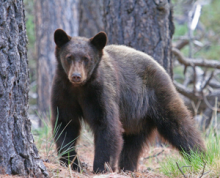Article
In some Native American traditions, the bear is considered the most powerful of all of the animals and is one of the most popular subjects of Native American artists. For the Navajo, historically there were two main species of bear that resided in Navajo territory: the grizzly bear (Ursus arctos) and the black bear (Ursus americanus). While the grizzly bear has been hunted to extinction in the Southwest, the black bear still inhabits mountainous areas in the Southwest, including those within the Navajo Reservation. Also known as "Mountain People," bears have complex symbolic and spiritual meanings. Bears are believed to be spiritual guides and represent strength and self-knowledge. The Navajo also believe that bears have supernatural powers, including great healing powers. The bear is a symbol of deliberate action, introspection, soul searching, and insight. In addition, the bear is the guardian of the West.
Bears are also taboo in Navajo beliefs. Some acts revolving around bears can cause “bear sickness.” This is probably due to the bear’s rather human appearance, especially when they are standing on their hind legs. Causes of bear sickness include killing bears or eating their flesh, touching an object a bear has touched, crossing a bear’s path, or drinking from a bear’s watering hole. The chantway ceremony used to cure “bear sickness” is the Mountainway Chant (see Mountainway Chant). Finally, bears are also associated with witchcraft, as they are thought, similar to the wolf, to be an animal whose powers and characteristics shapechangers and skinwalkers prefer to take.
"Black Bear, Burro Mountains, Grant County, New Mexico, July 14, 2009" by Mark Watson is licensed under CC BY-NC-ND.
Manuscripts
A01 The Blessing Way (01-05) p. 13
A01 The Blessing Way (01-05) p. 15
A01 The Blessing Way (01-05) p. 24
A01 The Blessing Way (01-05) p. 48
A01 The Blessing Way (01-05) p. 161
A01 The Blessing Way (01-05) p. 162
References
Pavlik, S.
1997 The Role of Bears and Bear Ceremonialism in Navajo Orthodox Traditional Lifeways.
Social Science Journal, 34(4), 475.

